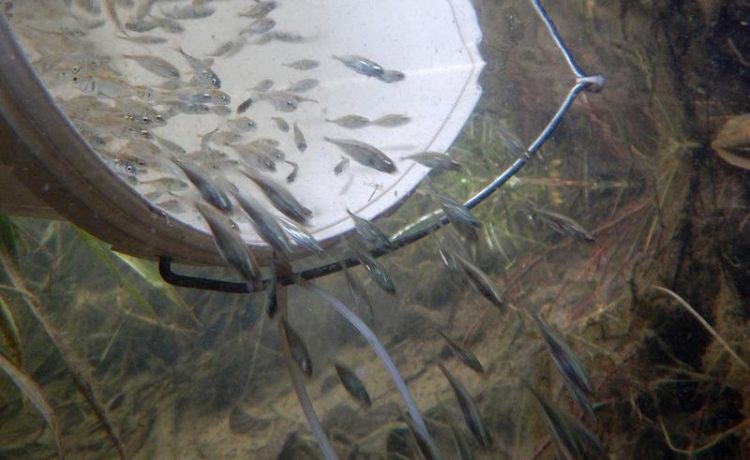Rapid evolution in fish: genomic changes within a generation

3000 experimental fish were released into a natural river habitat without stickleback, exposing them to natural selection. After one year, the remaining fish were recaptured and examined genetically. University of Basel, Dario Moser
Evolution is usually viewed as a slow process, with changes in traits emerging over thousands of generations only. Over the recent years, however, research has indicated that adaptation in specific traits can occur more quickly.
However, very few studies outside microorganisms were able to demonstrate empirically how quickly natural selection shapes the whole genome.
A research team led by Dr. Daniel Berner at the University of Basel’s Department of Environmental Sciences has now provided evidence for rapid evolution within a single generation, using threespine stickleback fish as model organism. The five-year study combined lab work, field experiments, mathematical modeling and genomic analysis.
Different habitats: lakes and rivers
In the Lake Constance area, stickleback have adapted to ecologically different In the Lake Constance area, stickleback have adapted to ecologically different habitats – lakes and rivers. To examine how quickly adaptation occurs across the genome, lake- and river-dwelling fish were crossed in the laboratory over several generations. The genomes of the two ecotypes were thus mixed, resulting in a genetically diverse experimental population.
In a second step, the researchers released thousands of these experimental fish into a natural river habitat without resident stickleback, exposing them to natural selection. After a year, the remaining fish were recaptured and examined genetically.
“The hypothesis of this experiment was that in the river habitat in which the experimental animals had to survive, genetic variants of the original river population would increase in frequency,” says Berner. “However, we had no idea whether this would be measurable within a single generation.”
Genomic analysis confirms hypothesis
To record potential changes in the genome, the researchers first had to identify the DNA regions most likely to be targeted by natural selection. To do so, they compared the original lake and river populations based on DNA sequence data.
This revealed hundreds of regions in the genome likely important for adapting to the lake and river conditions. In precisely these regions, the experimental population’s DNA sequence data from before and after the field experiment were then compared to identify changes in the frequency of genetic variants.
The result supported the hypothesis: on average, the frequency of the river variants increased by around 2.5% at the expense of the lake variants. “This difference might appear small at first glance, but is truly substantial when extrapolated over a few dozen generations,” says Berner.
The experiment demonstrates that evolution can occur very quickly right in front of our eyes – and not only in microorganisms. “Such rapid evolution may help some organisms to cope with the current rapid environmental changes caused by humans,” Berner concludes.
Dr. Daniel Berner, University of Basel, Department of Environmental Sciences, Tel. +41 61 207 03 28, email: daniel.berner@unibas.ch
https://www.nature.com/articles/s41467-020-15657-3
https://www.unibas.ch/en/News-Events/News/Uni-Research/Rapid-evolution-in-fish–…
Media Contact
All latest news from the category: Life Sciences and Chemistry
Articles and reports from the Life Sciences and chemistry area deal with applied and basic research into modern biology, chemistry and human medicine.
Valuable information can be found on a range of life sciences fields including bacteriology, biochemistry, bionics, bioinformatics, biophysics, biotechnology, genetics, geobotany, human biology, marine biology, microbiology, molecular biology, cellular biology, zoology, bioinorganic chemistry, microchemistry and environmental chemistry.
Newest articles

A new class of cosmic X-ray sources discovered
An international team of astronomers, led by researchers from the Astronomical Observatory of the University of Warsaw, have identified a new class of cosmic X-ray sources. The findings have been…

An open solution to improving research reproducibility
Academic and industry scientists collaborate on a new method to characterize research antibodies. Structural Genomics Consortium researchers at The Neuro (Montreal Neurological Institute-Hospital) of McGill University, in collaboration with scientists…

Living in the deep, dark, slow lane
Insights from the first global appraisal of microbiomes in earth’s subsurface environments. Which microbes thrive below us in darkness – in gold mines, in aquifers, in deep boreholes in the…



